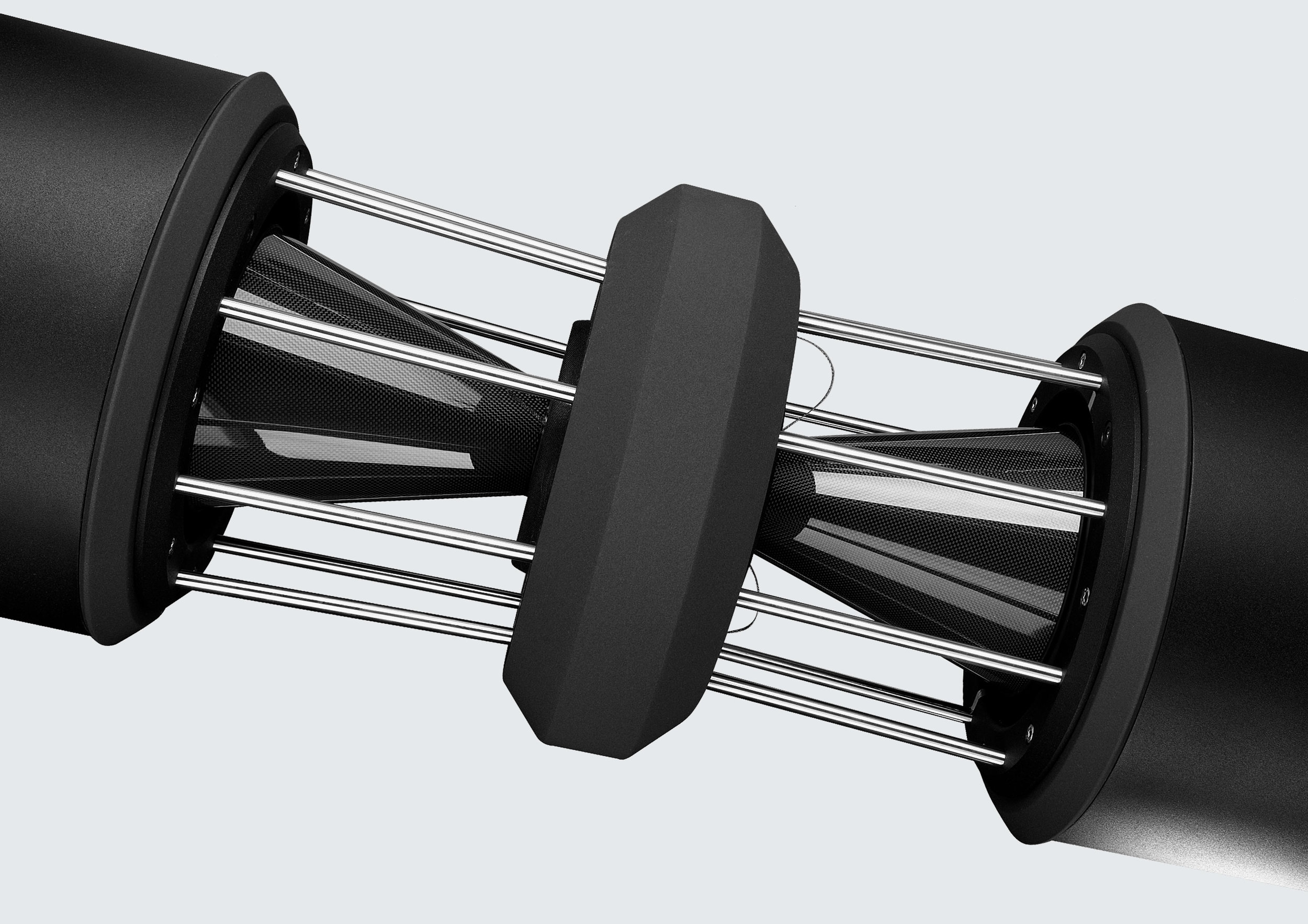
The heart of all German Physiks loudspeakers is the unique omnidirectional DDD driver
This is an expanded version of the text that you will find on the German Physiks loudspeaker products pages. It adds some extra detail that had to be omitted due to space limitations and which the reader may find useful.
The original version of the DDD driver used a cone made from 0.025mm thick titanium foil. Whilst providing an excellent sonic performance, it was also very fragile and easily damaged. The current version of the DDD driver uses a cone made from 0.15 mm thick carbon fibre. This version has a wider frequency range and it is also considerably more rugged. Each driver is hand-built by a skilled technician in our factory in Germany. This is a painstaking process that takes 6 hours. After assembly, each driver undergoes a series of rigorous tests. It is then subject to a 96 hour pre-aging process, playing specially selected music at high level. Finally, it is retested and put together with another driver to form a matched pair.
The DDD driver has two key distinguishing features
1. It is omnidirectional, meaning that it radiates the sound evenly around it.
2. It has an exceptionally wide operating range. In most models it typically covers the range from 200Hz up to 24kHz – almost 7 octaves – though in the Unicorn Mk II, it covers the range 40Hz to 24kHz – over 9 octaves.
This extremely wide range is achieved by the use of 3 modes of radiation
Pistonic radiation
Where the driver cone moves back and forward like the piston in a car engine.
Bending wave radiation
Where the driver cone flexes and a wave is made to travel down its side.
Modal radiation
Where the driver cone is allowed to go into break up and areas of excitation are created on the cone surface. In a simplified form we can think of these areas as looking like the pattern of waves we see when a stone is dropped into a pool of water. In reality the patterns will be more complex and they will change with frequency.
By comparison, most loudspeakers use drivers that only use pistonic radiation. These have a much narrower operating range and as the frequency rises, they tend to concentrate their energy into a progressively narrowing beam. This is explained in more detail here.
The DDD driver’s omnidirectional radiation characteristic and its wide operating range, together with a number of other key features give the same 8 important advantages to all German Physiks designs and is what sets them apart

1/8
Exceptionally Coherent and Natural Sound
The extremely wide operating range of the DDD driver provides an exceptionally coherent and natural sound. This is very difficult to achieve when this frequency range is split over two or more different types of driver, each with a different radiation characteristic and which are in physically different positions on the loudspeaker’s cabinet.
This excellent coherence is assisted by the fact that the DDD driver is comparatively compact, which makes it as close as we can currently get to an ideal point source.
Dick Olsher, in his review of the Unlimited MK II for The Absolute Sound commented on the importance of the coherence that the DDD driver provides:
“It only took me a few seconds to realize that this is a superbly coherent loudspeaker whose wave-launch more closely mimics live music than the disjointed presentation of a typical multi-way speaker. While I don’t intend to condemn all multi-way designs, the truth is that the great majority simply fail to coalesce into a coherent whole. That’s a direct consequence of slicing and dicing the music spectrum into pieces for consumption by tweeters, mids, and woofers arrayed on a large baffle. Such speakers may integrate reasonably well at a few points in space but move the measuring mike or your head a few inches and the balance shifts significantly.”
“Think of multi-way speakers as flickering in and out of coherence as the music spectrum slides up and down in frequency. The following sanitized acronym, intended to rhyme with FUBAR, pretty much captures my feelings about such speakers: MUBAR (muddled up beyond all recognition). In contrast, the DDD covers the entire vocal band and beyond. Being a proponent of wide-range driver designs, I should emphasize that the DDD is a brilliant example of this genre.”
Dick Olsher, The Absolute Sound, February 2014 (read review)
This wide operating range also eliminates the crossover point in the mid-range that loudspeakers using conventional pistonic drivers must have. Our hearing is most sensitive in the mid-range, which is where the human voice lies, therefore removing anything that might cause level or phase errors from this region will improve transparency.
2/8
Realistic stereo images more like you experience in the concert hall
When you listen to music in a concert hall, you are in an enveloping sound field where much of the sound is reflected off a surface before it reaches your ears. These reflections play an important part in the creation the stereo image that you perceive. Because the DDD driver is omnidirectional, it radiates all frequencies evenly around it and so creates a similar enveloping sound field in the listener’s room.
This way German Physiks loudspeakers are able to recreate a more natural rendition of the original stereo image. This has excellent depth and focus, but without the overly sharp image definition that some hi-fi loudspeakers produce and which you will rarely if ever hear at a live performance.

3/8
Stereo imaging enjoyable in almost all positions in the room
Conventional loudspeakers tend to produce stereo images that can only be best enjoyed from one position in the room, which we call the “sweet-spot” and then usually by only one person. As you move away from the “sweet-spot”, both the stereo image and the tonal balance become progressively degraded. This is because conventional pistonic drivers tend to concentrate their radiation into a beam that progressively narrows with increasing frequency.
By contrast, the DDD driver’s omnidirectional radiation pattern enables German Physiks loudspeakers to produce excellent stereo images that can be enjoyed from a wide range of listening positions in the room, whilst also maintaining a more even tonal balance: much like you would experience at a live performance.
This gives more flexibility in where you sit and allows several people to enjoy a good sound simultaneously, so you can more easily share your music with others. This is a useful attribute in home theatre systems.
In addition, because you are not restricted to a small “sweet-spot” in order to hear the best sound, German Physiks loudspeakers are able to provide a more relaxed listening experience. This is especially noticeable when you listen for long periods.
4/8
Exceptional dynamics
The DDD driver has a very low moving mass, less than 3 grams, so it can respond extremely quickly to transients, allowing it to recreate both the attack of the music and resolve low level detail very accurately. The resultant transparency is maintained even on complex high-level passages. Cymbals have an authentic initial smash and the ebb and flow of the subtle overtones that follow, is clear and unmasked. This ability is essential in order to faithfully reproduce the delicate nuances of a performance and make it sound like music, rather than just good hi-fi.
Once you have become accustomed to the more natural presentation provided by our DDD driver, it can be difficult to go back to listening to a conventional design. This is something we often hear from our customers and it has also been commented on in reviews, as Alan Sircom did writing in his review of our HRS-130.
"If you do find yourself liking the presentation of the HRS-130, going back to a direct radiating loudspeaker may prove impossible. It simply won’t sound right, anymore. This is not hyperbole: If you listen, and like, going back is difficult. It’s not just the imagery; the sound is naturally coherent, in a way that makes you think listening to a cone and dome box is listening to some drivers and a crossover.”
Alan Sircom, HiFi+, Issue 123 view/download pdf (1.5MB)
The DDD driver's excellent dynamic response also means that it does not compress the music the way other drivers may, consequently you are less likely to feel the need to turn up the volume in order to obtain a satisfying playback level. This is better for the long-term health of your hearing and because you are avoiding very high playback levels, you will be able to hear more detail in the music.

5/8
Accurate portrayal of musical instruments’ tonal characteristics
The DDD driver is phase linear across its operating range. This means that the phase relationships of the complex series of frequencies that make up the music signal are accurately preserved and this ensures that the tonal character of each musical instrument is reproduced with great accuracy. This together with the DDD driver’s excellent dynamic response enables German Physiks loudspeakers to reproduce percussion with startling reality.
Voices have a clarity and purity that can be breath taking, with all the elements that comprise the vocal sound correctly located in space and with no undue emphasis.
The hardness you often hear with conventional tweeters is eliminated and you get a greater sense of hearing a live musician rather than a recorded one.
6/8
Very quick and easy to set up
Due to their omnidirectional nature, German Physiks loudspeakers are less sensitive to room position than conventional loudspeakers and there is no toe-in adjustment to worry about.
This ease of set-up has been commented on in several reviews.
In his review of the Unlimited, Jeff Dorgay of Tone Audio commented:
“While these speakers do benefit from about 20 minutes of optimizing the bass driver in the room, those with no speaker setup skills will still be able to achieve excellent results. I’ve never used a pair of speakers that were this easy to place in my three listening rooms.“
Jeff Dorgay, Tone Audio, July 2013: read review

7/8
The DDD driver is less likely to excite cabinet vibrations
The DDD driver puts less energy into the cabinet than an equivalent conventional driver would. This reduces cabinet resonances and gives a major increase in transparency. There are two reasons for this:
a. The DDD driver has a very low moving mass, much less than most equivalent conventional drivers, therefore the reaction forces are much smaller and so there is less energy to cause resonances.
b. The second reason is the way the DDD driver is mounted. On conventional loudspeakers, the driver is generally mounted on a baffle and the reaction forces the driver produces are in the same direction that the baffle would naturally want to flex.
By contrast, on the German Physiks Unlimited, HRS-130, Borderland MK IV and Carbon MK IV, the DDD driver is mounted on top of the cabinet. The reaction forces the DDD driver produces are therefore at right angles to the direction that the cabinet panels would naturally want to flex, so it is very difficult for the energy from the DDD driver’s reaction forces to make the cabinet resonate.
On the German Physiks PQS-203 to Emperor, the DDD drivers use very small cylindrical enclosures, minimizing the area of any potential vibrating surface. By being cylindrical, they eliminate the resonances that can arise with a conventional rectangular or square section cabinet. Because they are made from aluminium, a comparatively soft metal, residual vibration of the enclosure is minimized. The DDD driver enclosure end-caps are made from non-resonant MDF and the enclosure is packed with damping material to dissipate any standing waves.
The result is that German Physiks loudspeakers have a degree of transparency and lack of colouration that is comparable to an electrostatic loudspeaker.
8/8
Physically extremely rugged
The DDD driver is almost certainly the most rugged loudspeaker driver on the market and can withstand abuse that will destroy drivers made from hard materials like ceramics, beryllium or diamond. This is useful if the loudspeaker is to be used in a household with small children, or partners who are compulsive dusters. Just how much abuse the DDD driver will withstand is illustrated in the video below. We don’t advise our customers to try this however, just in case they are having an unlucky day.
More information on the DDD driver, its development and advantages may be found here.
For information about the development of the DDD driver please click here

